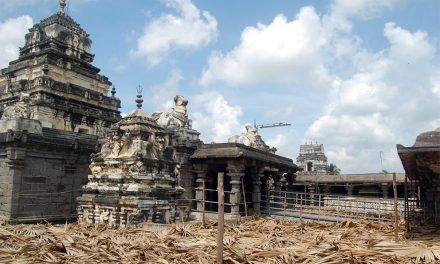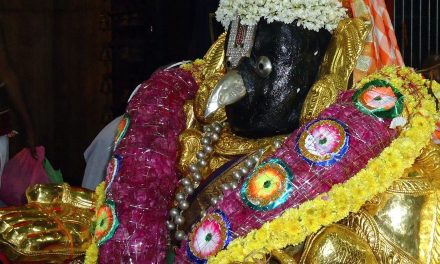The River Ganga has a long history of reverence in India and is worshipped by Hindus as an embodiment of the transcendental personality, Ganga Ma. The total length of the river is about 2,510 km (1,557 miles). Along with the Yamuna River, it forms a large and fertile basin known as the Gangetic plains, stretching across north India and Bangladesh, supporting one of the highest densities of human population in the world. Indeed, about one in every 12 people on earth (8.5% of world population) live in its catchments area. Due to this incredible concentration of population, pollution and the destruction of habitats is a matter of serious concern. The area features prominently in today’s global warming discussions, as a rise in sea level could have a devastating effect on this massive population.
Ganga in Vedas
The Ganga is mentioned in the Rig-Ved, the earliest of Hindu scriptures, in the Nadistuti (Rig Veda 10.75), which lists the rivers from east to west. In RV 6.45.31, the word Ganga is also mentioned, but it is not clear if the reference is to the river.
RV 3.58.6 says that “your ancient home, your auspicious friendship, O Heroes, your wealth is on the banks of the Jahnavi (JahnAvyAm)”. This verse could possibly refer to the Ganga. In RV 1.116.18-19, the Jahnavi and the Gangetic dolphin occur in two adjacent verses.
During the early Indo-Aryan Ages, the Indus and the Saraswati were the major rivers, not the Ganga. But the later three Vedas seem to give much more importance to the Ganga, as shown by its numerous references.
According to the Puranas, Goddess Ganga used to exist only on the heavenly planets. Then prince Bhagirath worshipped Ganga, imploring her to descend on earth. This is why Ganga is also known as Bhagirathi. In the Mahabharat also this story is mentioned. In fact, Ganga is a major character in the Mahabharat, as she is the mother of Bhisma. The devout in India believe life is incomplete without bathing in the Mother Ganga at least once in their lifetime.
The Ganga in Hinduism
Varanasi is closely associated with Ganges. The town has many temples along the banks of the Ganges. Hindu belief holds that bathing in the river on certain occasions causes the alleviation of karmic burden and helps attain salvation. Many people believe that this will come from bathing in Ganga at any time. People travel from distant places to immerse the ashes of their kin in the waters of the Ganga; this immersion also is believed to help the deceased living entity gain liberation.
Many sacred places lie along the banks of the river Ganga, including Haridwar and Kashi. Perhaps the most important sacred city on the banks of the river Ganga is Varanasi or Banaras, which has hundreds of temples along the banks of the Ganga that are often flooded during the rains. This city is an important place of worship as well as a cremation ground.
After making the pilgrimage to Kashi, people carry from the Ganges sacred water that is sealed in copper pots. It is believed that drinking water from the Ganga with one’s last breath will liberate the soul. In most Hindu families, a vial of water from the Ganga is kept in every house. This is done because it is auspicious to have water of the Holy Ganga in the house, and also if someone is dying, that person will be able to drink its water.
Many believe that the water from the Ganga can cleanse a person’s soul of all past sins, and that it can also cure the sick. The ancient scriptures mention that the water of Mother Ganges carries the blessings of the Lord’s feet. Hence the Ganges is also known as Visnupadi [Emanating from the Lotus feet of Supreme Lord Sri Visnu].
Some of the most important Hindu festivals and religious congregations are celebrated on the banks of the river Ganga, such as the Kumbh mela or the Kumbh fair and the chhat puja. In this brief series, we will explore the history of the Melas.
Kumbh Mela is the largest religious gathering on Earth for Hindu peoples. Around 70 million Hindus from around the world participated in the most recent Kumbh Mela at the Holy city of Prayaga (also known as Allahabad).
Geography
The Gangotri Glacier in the Uttaranchal Himalayas is the origin of the Bhagirathi river, which joins the Alaknanda river at Devaprayag, also in the Uttaranchal Himalayas, to form the Ganga. The river then flows through the Himalayan valleys and emerges into the north Indian plain at the town of Haridwar. This section sees extensive Whitewater rafting and kayaking from September to March.
From the Ganges river delta, Bangladesh and India, the Ganga then flows across the broad plains of north India, (called the Gangetic Plains), and forms the major river basin of that vast region. Its tributaries include the Kosi, the Gomti, the Sone, and above all the Yamuna. The Yamuna River – a major river in its own right, and nearly as endowed with the sanctity of Religious tradition and legend as the Ganga, is in fact a tributary of the Ganga; their confluence marks the site of the pilgrim town of Prayag, now known as Allahabad. Not only sites of vast religious significance, they are also home to the most populous industrial cities of northern India, including Kanpur, Allahabad, Varanasi and Patna.
Early morning on the Ganges at the city of Varanasi, swollen by the waters of a wide basin that draws from watersheds as diverse as the Himalayas and the Aravallis, the Ganga forms a formidable current in the stretch between Allahabad and Malda, and thereafter, a large delta. Near the town of Malda in West Bengal, it undergoes its first attrition with the branching away of the Hoogly, its first distributary. The city of Kolkata (Calcutta) stands on the banks of the Hoogly. The main stream of the river, known as the Padma River, then enters Bangladesh. Here, it unites with the Jamuna branch of the even larger Brahmaputra River. The combined stream then joins with the Meghna River before flowing out to sea. In the flat plains of Bangladesh, the Ganges splits almost immediately into a dense network of distributaries, all of which finally empty into the Bay of Bengal.
The region encompassing the delta near the Bay of Bengal coast is known as The Sundarbans (Beautiful Forests) – a region of thick mangrove forests, and one of the major habitats of the Royal Bengal Tiger. Two species of dolphin can be found in the Ganges, the Ganges River Dolphin and the Irrawaddy Dolphin. The Ganges is also notable in that it contains a rare species of freshwater shark, Glyphis genetics, about which little is known.
Yamuna
The Triveni Sangam, or the intersection of the Yamuna River and Ganges River, is a particularly sacred site. The Yamuna (sometimes called Jamuna) is a major river of northern India, with a total length of around 1370 km. It is the largest tributary of the Ganga. Its source is at Yamunotri in the Uttaranchal Himalaya, which is north of Haridwar in the Himalayan Mountains. It flows through the states of Delhi, Haryana and Uttar Pradesh before merging with the Ganges at Allahabad. The cities of Delhi, Mathura and Agra lie on its banks. The major tributaries of this river are the Tons, Chambal, Betwa, Sindh and Ken; with the Tons being the largest. The Yamuna was called Ioames by the ancient Greeks, and Jomanes by the Romans.
There is some evidence indicating Yamuna was a tributary of the Ghaghra river in the ancient past. It changed its course to east following a tectonic event in north India and became a tributary of the Ganges instead.
The personification of the river, known as Yami, is the sister of the Yamaraja, the god of death, and the daughter of Surya, the Sun god. The river Yamuna is also closely tied to Sri Krsna’s Vrindavan pastimes.
The area of the Yamuna is also home to the Asian Elephant. West of the Yamuna there are no elephants to be found over 900 km of the western Himalayas and their foothills. The forests of the lower Yamuna offers ideal corridors for elephant movement. The principal forests to be found here are of Sal, Khair (Acacia), and Sissoo (Rosewood) trees, and the Chir Pine forests of the Shivalik Hills.
Sarasvati
The Sarasvati River is an ancient river that is mentioned in sastra as one of the chief Rigvedic rivers. The Nadistuti hymn in the Rigveda mentions the Sarasvati between the Yamuna in the east and the Sutlej in the west, and later texts like the Mahabharat mention that the Sarasvati dried up in a desert.
The name is descended from Proto-Indo-Iranian saras-vnt-i, meaning “she with many pools” (Sanskrit saras- “pool, body of water”), cognate to Avestan Harahvaiti, the name of the Helmand River, and Old Persian Harachuwati, in Achaemenid times the name of the Arghandab River, chief tributary of the Helmand.
Most scholars agree that at least some of the references to the Sarasvati in the Rigveda refer to the Ghaggar-Hakra River, while the Helmand is often quoted as the locus of the early Rigvedic river. Whether such a transfer of the name has taken place, either from the Helmand to the Ghaggar-Hakra, or conversely from the Ghaggar-Hakra to the Helmand, is a matter of dispute.
There is also a small present-day Sarasvati River (Sarsuti) that joins the Ghaggar river.
The goddess Sarasvati was originally known as the divine personification of this river, and later she developed an identity and meaning independent from the river.
The present-day Sarasvati (Sarsuti) originates in a sub-mountain region (Ambala district) and joins the Ghaggar near Shatrana in PEPSU. Near Sadulgarh (Hanumangarh) the Naiwala channel, a dried out channel of the Sutlej, joins the Ghaggar. Near Suratgarh the Ghaggar is then joined by the dried up Drishadvati river.
Triveni Sangam at Allahabad
The Triveni Sangam in located on the banks of the Ganges and Yamuna, in Allahabad. Sangam in Hindi language means confluence. The Triveni Sangam in Allahabad is a confluence of three rivers: the Ganga, Yamuna and Saraswati. Of these three, the River Saraswati is invisible and is said to be flowing beneath the earth. It meets the other two rivers from the base. The point of confluence is a sacred place for the devout, and is of high religious importance. A bath here is said to wash all karmic burden and free the human from the cycle of birth.
The site of Sangam is a treat to the eyes. One can see the muddy and pale yellow water of Ganges merging with green water of Yamuna. The Ganges is only 4 ft deep, while Yamuna is 40 ft deep near the point of nexus. The river Yamuna ends at this point while the Ganges continues after this till it meets the sea at the Bay of Bengal.
The Triveni Sangam is understood to be the same place where drops of Nectar fell out of a pitcher, from the hands of the demigods, so it is believed that a bath in the Sangam will also bring mukti. Devout Hindus from all over India come to this sacred pilgrimage point to offer prayers and take a dip in the holy waters.
The Sacred Kumbh Mela is held every 12 years at the banks of the Sangam. According to myths, the Prakrista yajna was first performed here by Lord Brahma. That is how Allahabad received its ancient name, Prayag. Allahabad is also called Tirtha-Raja (Prayag Raj), king of all holy places. It is said that Lord Rama visited Allahabad when He was in exile.













